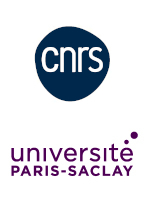
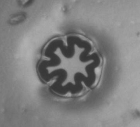
Adhesion of soft polymers
We investigate experimentally the adhesion of ribbons of viscoelastic polymer, and in particular the fundamental relation between their adhesion level, the rheology of the adhesive and the interfacial properties of the substrate.
To reveal the fundamental mechanisms of energy dissipation driving the adhesion, we use micro-textured substrates and control their surface properties by chemical processes.
Read more 

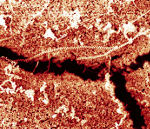
Stability of a coating submitted to cycling mechanical stresses
How does a crack network evolve under the effect of a cycling mechanical stress? We consider the case of a nanospring coating.

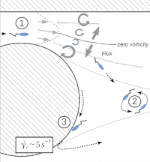
Swimming of bacteria in porous media
Soils, sediments, biological gels and tissues are environments in which microbes proliferate. Their transport is controlled by complex flows with implications in health sciences, agriculture, ecology... By combining microfluidic experiments, numerical modeling and multiscale approaches we aim to capture the influence of pore structure on the transport and dispersion of motile bacteria. The figure shows how the coupling between motility and flow allows bacteria to accumulate at the back of a grain. See our publications for more.

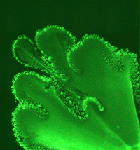
Viscous fingering and flow of active fluid
The situation where one fluid is displaced by a second one is a basic situation found in many applications.
Our investigation focusses on the possible flow changes arising when one of the fluid is active. This is achieved here by using suspensions of various strains of motile bacteria injected in Hele Shaw cell.

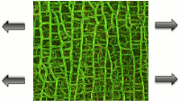
Crack patterns in paintings
The large variety of craquelures reveal some characteristics of the pictorial layer. Moreover studying the stability of a crack network is essential in the domain of heritage conservation. The formation of a crack network is investigated using model systems in a multi-layered geometry.

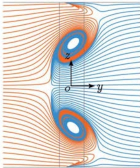
Mélange de fluides miscibles induit par gravité
How to mix fluids in microfluidic devices? This simple question remains a serious challenge. In the method considered two fluids are injected face to face in an intersection of 4 channels. For moderate Reynolds numbers (around 20), one or several vortices appear in the intersection allowing a good mixing of the fluids. The quality of the mixing and the number of vortices have been studied as a function of the angle of the intersection and of the aspect ratio of the channel sections. The image shows the formation of 2 vortices on the height of an intersection of large aspect ratio.

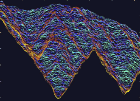
Chemical wave fronts in disordered flow
Interface motion are relevant to a wide variety of dynamical processes including population dynamics in biology, chemical reaction, solidification, flame propagation in combustion and marine ecology systems. We investigate the coupling between reaction fronts and disordered flow through a model porous medium. The front is generated by a reaction between two chemical species which produces Fisher waves. These reaction fronts propagate as solitary waves with a constant velocity and a stationary concentration profile. We study the dynamics and morphology of these fronts resulting from the interaction between the flow and the sustained reaction.

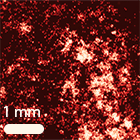
When bacteria play marbles
The formation of dense phases in systems containing self-propelled agents is a fascinating phenomenon of active matter. Our recent experiments show that swimming bacteria induce the clustering of micrometer-sized beads, yielding giant clusters up to several millimeters, visible to the naked eye. This clustering process follows a self-similar dynamics analogous to the Ostwald ripening mechanism without apparent saturation. These observations are very promising for the generation of large structures of passive colloidal particles.

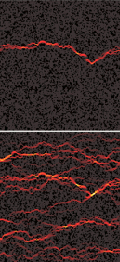
Yield stress fluid flow in porous media
The non-Newtonian fluids intervene in numerous industrial processes.
The flow of yield stress fluids, viz. that require a minimal shear stress for flowing, is investigated in different heterogenous media (porous media, factures...).
The presence of heterogeneities induces many different flowing regimes that we aim to characterize.

Blistering induced by wetting and drying of colloidal coatings
Blistering affects the final quality coatings. This process results in the delamination process of colloidal films from the substrate.
The formation of blisters are analyzed for various colloids as a function of successive wetting and drying processes.




